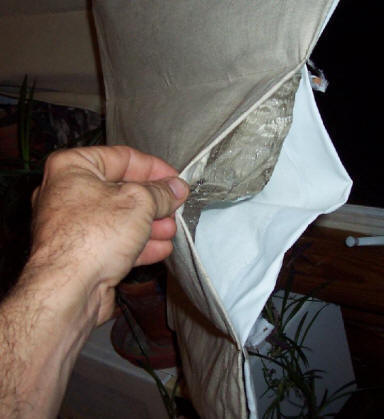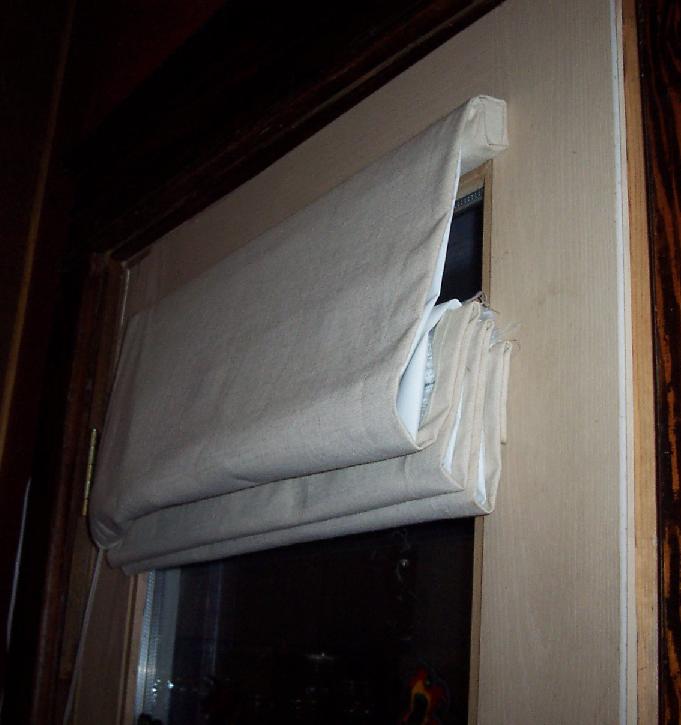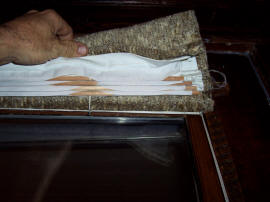
Search
The Renewable Energy site for Do-It-Yourselfers
Ray's Roman
Thermal Shades
Thanks very much to Ray for providing
the description and pictures of these high insulation value thermal shades!
Ray's Description:
These shades are a compromise between efficiency and
looking nice. The radiant barrier in the middle is aluminum. It reflects 90
something percent of radiant energy in either direction. It is best if it is
not touching anything on either side, but shades made of radiant barrier alone
would look kind of like living in a spaceship or something. I added a white
backing to reflect out summer sun, add insulation and look nice from the
outside. I also added a facing fabric inside to add insulation and look nice
from inside. The radiant barrier is sandwiched as loosely as possible in
between to allow it to be as efficient as possible.
I built these shades myself. I spent about 3 to 4 hours to
cut, iron, hem, sew, string and hang each one. They operate like Venetian
blinds, but are fabric and they kind of fold or pleat as they are raised. I
used a standard design for making Roman Shades. The cost was pretty high. I
spent about $600 on materials in 2005 to build 18 curtains. That’s over $30
each. I shopped around for end pieces and had some fabric given to me, too.
Expect to spend more than I did.
The shade is made in 3 layers. The facing layer can be any
material you like at all, it’s just there for aesthetics, but the thicker it is
the more insulative value it adds. My book said to hand stitch everything on the
face layer to prevent seeing the hems. You gotta be kidding me. I have 18
curtains to build, kids, goats, chickens and a cow to take care of, work to show
up for, machines to repair, a farm to run and a life to live. I did use the
treadle sewing machine, though, ‘cause I like it and they came out looking just
fine.
Click on the pictures to enlarge.
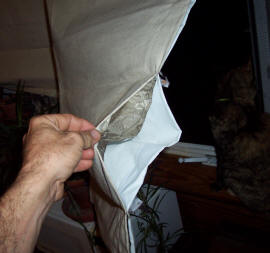
The layer in the middle is cut from a roll of radiant
barrier from Heartland supply. http://www.astrofoil.net/ . I have also used
this radiant barrier in the attic and in the crawl space (be sure to use the
perforated kind in the attic to prevent moisture buildup)
The backing I used is called “blackout.” It is white,
thick and insulative and kind of pricy, but worth it. It is a common curtain
backing at any fabric store.
The facing layer and backing layers are cut and hemmed
separately. Then they should be layered with the radiant barrier in the middle
and pinned together. The back sides of the curtains have a sleeve sewn on at
regular intervals. A wooden dowel is slid into each sleeve. Spacing of the
sleeves is purely up to you. I suggest spacing them in the 6 to 10 inch range.
Sleeves can be purchased as a long roll. I bought them at a JoAnn’s fabric
store. It is called Roman shade tape. I could have made the sleeves myself,
but decided the time and material I would have used wouldn’t have been worth it.
The top of the shade is wound around and stapled to a 1x2
piece of wood. The wood is then screwed to the window frame.
My book said to hand sew on rings for the 2 cords to run
through. I slit open the sleeves and ran the strings behind the dowels
instead. I used masons twine for cord. For the “pulley” system, I used 3 small
eyelets screwed into the wood. I didn’t use one of those self locking devices
that hold the cords of a Venetian blind. I tied the 2 cords together at the end
and put a screw in the window frame to hook the tied together ends around.
It is important that the shade fit as tightly as possible
in the window opening to stop any drafts. Build them to be about ¼ inch wider
than the opening and about 3 inches taller than the opening. I made the face of
the shade about ¼ inch wider than to window frame to stop drafts. I made the
radiant barrier about 1 inch narrower than the window opening to prevent it from
binding. I also made the backing about ½ an inch narrower than the window frame
to prevent it from binding on the window frame. The pockets and dowels can be
several inches narrower than the window frame, too.
The shades with the radiant barrier in them are kind of
stiff, but the radiant barrier has a good memory of its folds, so the shades
pleat and fold the same way very reliably.
I lived without shades for a year, then with Venetian
blinds for a year, then with these shades for 2 years. My experience is that
lacy curtains look nice but have no thermal value, Venetian blinds help
considerably and heavy curtains with radiant barriers help way more than
blinds. I bet I halved the amount of wood I burn.
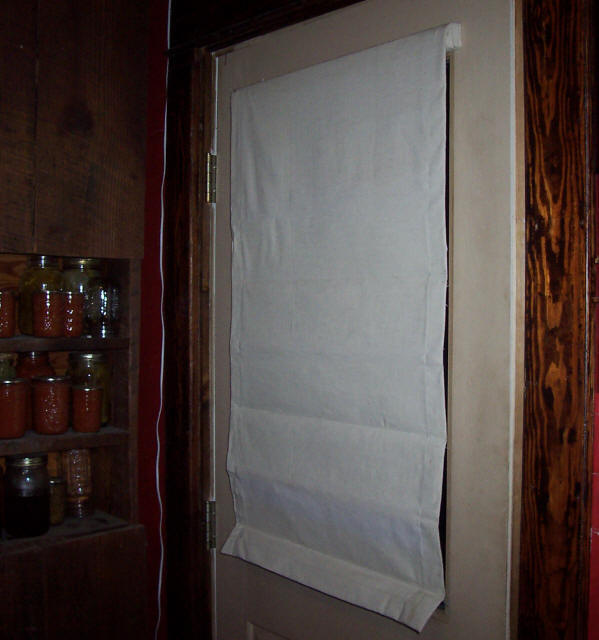
Ray Milosh
You can email questions to: raymilosh AT hotmail DOT com (replace AT
with @ and DOT with a period)
Oct 17, 2007

